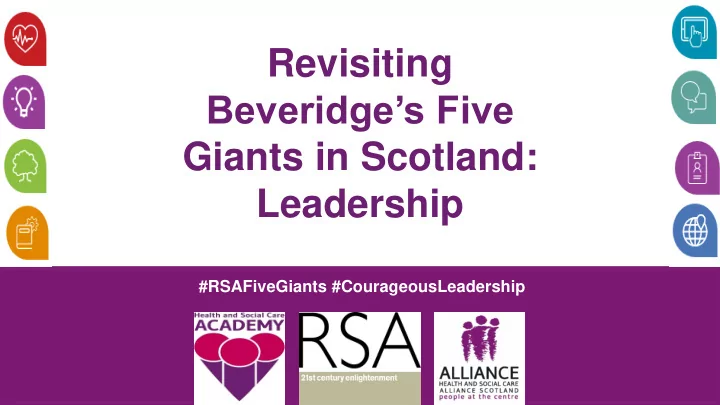

Revisiting Beveridge’s Five Giants in Scotland: Leadership #RSAFiveGiants #CourageousLeadership
Welcome! Clare Cable Chief Executive and Nurse Director, Queen’s Nursing Institute Scotland, and Honorary Professor, Queen Margaret University, Edinburgh
Background Lucy Mulvagh FRSA Director of Policy and Communications, the ALLIANCE
Health and Social Care Academy
If you think you have nailed it, you have failed it! Mairi O’Keefe Director of Ceannas and Patron of Leuchie House
Work together effectively to achieve outcomes Bill Alexander Associate, Children in Scotland
“Work together effectively to achieve outcomes” Christie Commission 2011 Bill Alexander Children in Scotland Associate
“Scotland's public services are in need of urgent and sustained reform to meet unprecedented challenges….. The economic downturn will also intensify and prolong demand. Unless Scotland embraces a radical, new, collaborative culture throughout our public services, both budgets and provision will buckle under the strain.” Christie Commission Report, 2011
Christie: The key objectives of the reform programme must be to ensure that - • public services are built around people and communities • public service organisations work together effectively to achieve outcomes – specifically, by delivering integrated services • public service organisations prioritise prevention, reduce inequalities and promote equality; • all public services constantly seek to improve performance and reduce costs, and are open, transparent and accountable
“The overwhelming message is that the answer to the delivery of more effective children’s services is not more structural change…. Nevertheless, there is widespread recognition that there is scope to improve current strategic and operational arrangements within existing children’s services structures.” Brock / Everingham 2018
Media Social Psychological Economic Food Activity Infrastructure Developmental Biological Medical Systems map on causes of obesity produced by the UK Government Office for Science in 2007
ADES Thinkpiece (2019) “Simple hierarchical lines of line management and accountability have been complicated by developments that have facilitated staff to work across a far greater range of boundaries. These networked systems and polycentric forms of governance offer significant opportunities. They also bring additional complexity, in the sense that we are developing a hybrid, which at one level continues to operate through hierarchical structures, but has increased lateral capacity across the system.”
Different types of leadership Personal leadership: influenced by individual style & personality. Organisational/departmental/sector leadership: partial role and purpose. System leadership: collective context influenced by shared purpose and ambition; relational and emergent: generative conversations and co- creating the future. “..organizational self -interest becomes re-contextualized, as people discover that their and their organization’s success depends on creating well- being within the larger systems of which they are a part” Peter Senge – “The Dawn of System Leadership”. https://ssir.org/articles/entry/the_dawn_of_system_leadership
GOVERNANCE VISIONS AND VALUES SYSTEM LEADERSHIP There is an explicit and active governance Leaders demonstrate system leadership, structure across services for children, that Partners share, articulate and evidence a working to collective priorities, and enables collective decision making to coherent vision and values about how to partners embrace whole system change to deliver the GIRFEC Approach, while also achieve the best possible outcomes for redesign services to embed the GIRFEC providing clarity about management roles children and young people. Approach. and responsibilities. CONTINUOUS IMPROVEMENT ENGAGEMENT COLLABORATION The partnership uses strategic needs Partners, ensure that children, families, assessment and qualitative and staff and other stakeholders are involved Collaborative working is promoted across quantitative data to inform service and engaged in the development of the and between partners to achieve high planning, drive continuous improvement, vision and in service planning and levels of performance. and to deploy resources to fulfil the vision. improvement processes. DISTRUBUTIVE EMPOWERMENT LEARNING CULTURE Senior managers enable distributive Work is appropriately delegated, and staff leadership to encourage as many people Leaders have established a learning are supported and successfully motivated as possible to take responsibility and culture, and are open to challenge and and empowered to improve outcomes for generate effective and innovative new possibilities. children and young people. solutions.
What people know
What people know
My journey through health and social care Claire D’All Disability Activist, A Journey in my Wheels
Speaker and audience discussion
Table discussions and networking
Thank You! Closing remarks • Clare Cable
Recommend
More recommend